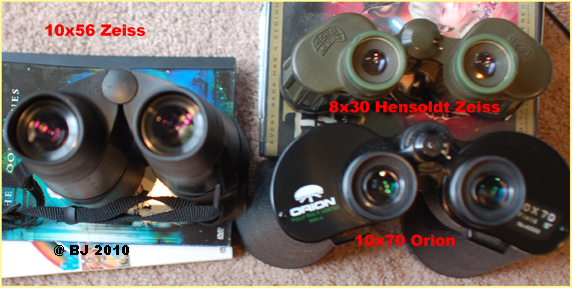

First Review: The Zeiss 10x56 Night Owl Binocular is compared to five other high quality binoculars. (plus five additional writeups about binoculars that I didn't have for the original side by side testing against the Night Owl). I'll begin with a rather lengthy piece about each of ten binoculars, then move on to the actual side by side testing of the original five binoculars and the conclusions.
The Zeiss 10x56 Night Owl was a "cost is no object" roof prism with center focus and total sealing for waterproofness/fogproofness. It was introduced in the early 1990s. It was made in limited quantities and was dropped in the late 90s, when Zeiss deserted its heritage of 150 years worth of perfecting the use of lead otical glass, in favor of new "Green" glass formulations without lead. The Night Owl has the very best Zeiss T* (T-Star) and enhanced phase coatings, and copious amounts of perfect lead glass. The Night Owl's fame is in two pieces. One is the simple fact that it and its cousins in the Zeiss line-up of the 1990s were the culmination of 150 years of Zeiss' perfecting of lead optical glass, indeed laying claim to the title, "The last and best of the Zeiss leaded glass binoculars."
The fame of the 10x56 model in particular lies in its being the largest aperture leaded glass roof prism that Zeiss ever offered commercially, and for sure the BEST. They were made in limited quantities and are now quite rare. Officially, the Night Owl was designated as part of the Zeiss’ "Design Selection" series, full name, the "Carl Zeiss Dialyt 10x56B/GA DS T* C.F." The exterior of mine is in the "Black Forest" rubber color, list price on the Nov. 1, 1994 Zeiss price list was $1,775.00. ("DS" stands for Design Selection). The big 56mm objectives boast a construction of exotic "wide-angle telelenses of the Superachromat type," while the large prisms are of the sophisticated Abbe-Konig type, with "optimized phase correction." The term "Night Owl" is used by Zeiss to describe the awesome performance of the Design Selectioin series under dim, challenging light conditions. Of course, this makes them also superb for astronomy!
Binoculars in the Test: (picture below shows six binoculars, four reviewed immediately, the other two reviewed near page bottom-- the Night Owl is at the top middle position, with the obvious strap extending left-ward)
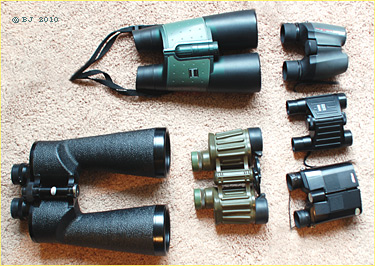
1. Hensoldt 8x30 DF porro prism, wide angle, with individual focus and green, ribbed armor (pictured above, lower middle)-- a newer, minty example.. Note: "Hensoldt" brand is actually a subsidiary of Carl Zeiss, and for many decades have manufactured the Zeiss binoculars for the military in Germany and elsewhere under contract. In essence, these Hensoldts being tested are "Military Zeiss" optics.
2. Another Hensoldt 8x30 DF, an older one, perhaps the coatings are different and less good. (this is not pictured but looks just like #1)
3. The Nikon 8x23 AS (aspherical) Diplomat, a member of Nikon's Companion Deluxe series. Best Nikon coatings. Standard FOV of 50 degrees. Reverse porro design, center focus, introduced in early 90s and still in their 1997 catalogs. Very lightweight and with good ergonomics. (pictured above and also near page bottom)
4. The Orion 10x70 FMC porro prism (fully-multi-coated), standard FOV of 50 degrees, center focus. All metal body, solid, somewhat heavy. Pictured above. Made in Japan (not China, yeah!).
5. The Optolyth 15x63 Royal. A roof prism
with the very best Optolyth Ceralin Plus coating and phase coatings.
Wide-angle and Center focus (not pictured).
6. (too late for the original testing) The Zeiss 8x30B GA roof prism, late model of their famed Classic Diaylt with the newest P-Star and T-Star coatings. Very wide-field and very compact. Hint-- I will state right now that this was the BEST 8x30 leaded-glass binocular ever produced by Zeiss. I will post more specifics at a later date.
7. Docter 8x32 Aspherical roof prism. Docter took over the original Zeiss Jena operation circa 1990, and went on to improve an already legendary line. One of their efforts was an updated version of the well-known Carl Zeiss Jena "Notarem" line. The new version sported superb multi-coatings, an innovative elastomeric rubber armoring, and state of the art aspherical lenses (my sample produced circa 1995). My review of this binocular and pictures will be added soon (by March 15, 2011). Hint-- this is a very fine binocular, with very good resolution, and a nice flat field! Its main drawbacks are its fairly heavy but very solid build (1.54 lbs with strap), and its Swarovski-like slightly "warm" slightly yellowish image quality. Pictures and more on the 8x32 and 10x40 Docter Ashericals here.
8. Swarovski 7x42 Habicht roof prism.
This is a model from about 1996, but has phase coatings. I have
taken the pictures and done the testing but probably won't have
time to post the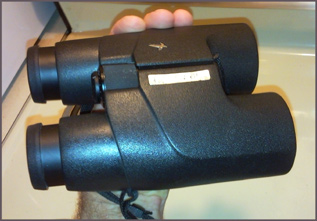 results until January 2011. This is a very fine binocular, with
high ease of use and comfort in the hand. The image is very relaxed
and easy. Glare suppression under extreme lighting challenges
may be the best I have seen, besting even the Zeiss Night Owl.
The Apparent FOV, however, is not as large as the Zeiss, and the
relative lack of aperture and low power makes its night sky views
much less impressive than the Night Owl. It's also somewhat bulky
and heavy (31.3 oz) for its modest aperture and modest magnification.
results until January 2011. This is a very fine binocular, with
high ease of use and comfort in the hand. The image is very relaxed
and easy. Glare suppression under extreme lighting challenges
may be the best I have seen, besting even the Zeiss Night Owl.
The Apparent FOV, however, is not as large as the Zeiss, and the
relative lack of aperture and low power makes its night sky views
much less impressive than the Night Owl. It's also somewhat bulky
and heavy (31.3 oz) for its modest aperture and modest magnification.
9. Optolyth 10x40 classic porro, with the black ribbed rubber armor. A German-made, wide-field, and extremely lightweight binocuar by one of the oldest binocular manufacturers in the World. A fuller discussion will eventually be posted, but these little jewels are hard to beat as your "take a peek" binoculars for astronomy. So light and compact that they hide unobtrusively inside your warm coat on a frosty night and don't get all fogged-over! Great light transmission, nice sharp images, smooth focus, probably 85-90% of the optical performance of the Zeiss Classic 10x40 for 60% of the new price, and about 1/4 the price on the used market.. Its main shortcoming for me is that one of its positive attributes, its small size and very light weight, cause it to be difficult to hold steady enough to take advantage fully of its 10 x magnification. Once mounted on a tripod, however, this problem vanishes and indeed the optics are very sharp on stellar objects like Orion or the Pleiades.
10. Brunton Eterna 15x51 roof prism.
I saw a glowing review by Kimball Corson of this high-power binocular
on AstroMart, dated 12/1/2006. Recently I was able to find it
for an extremely good price (new, $295, postpaid)..(Image) That's
the Brunton on the left with "camo" colored rubber armor.
On the right is a classic 10x50 all-metal porro prism binocular
by Tasco.... My Report---. 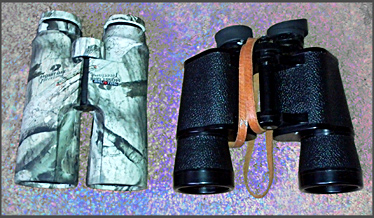 I
am somewhat surprised to report that the Brunton 15x51 fully lives
up to the AstroMart review, representing a truly fine astronmical
binocular, small and light enough to hand-hold, yet powerful enough
with enough light-gathering to do a fine job with typical binocular
objects such as the Andromeda Glaxacy, the Perseus Double Cluster,
M42 in Orion, or M45 the Pleiades. It weighs only 1.91 lbs, and
has a true FOV of 200 ft. at 1,000 yards, or 3.8 degrees, with
a 57 degree apparent FOV. Its ease of view is good, but less than
the totally relaxed, open feeling of the best Zeiss or Swarovski,
and the same can be said for its mechanics. Its camo armor is
weird, but feels good in the hand, and this 15-power binocular
holds amazingly well for such a high magnification. When I tested
it on the night sky, I aimed at a familar binocular object, the
small triangular asterism that has Vega as its "primary,"
in the constellation of Lyra... The three stars nicely filled
the FOV from side to side, showcasing the extent of this binocular's
3.8 degree field. I was quite pleased to note that the field stayed
nice and flat nearly to the edge. In fact, once tripod-mounted,
I was able to split the double star that is the closest of the
three main stars of this asterism, Zeta Lyrae at a separation
of only 44"-- this pleased me greately. The "wide angle"
effect of the Brunton is good, but it only has a 57 degree apparent
field, as compared to the 63-65 degree fields of comparable Zeiss
or Swarovski. The Brunton comes with a "case" that is
definitely unusual, and quite creative; it's comprised of two
separate pieces of camo-colored neoprene, a "Bino-Glove"....
One slips over each barrel. I like them,but worry about their
durability and how easy they will be to loose and then how would
I replace? (Contact Brunton, Riverton, Wyoming). I discoverd that
my old fashioned, hard shell leather case for the Tasco 10x50s
was a great fit for the Bruntons for a more durable case. Finally,
the Brunton comes supplied with a special tripod adapter that
screws into the very limited clearance at the center post. It
is a real pain to take on and off due to the tiny clearances,
but
works well once installed and at 15x you'll need it for certain
uses like any serious astronomy of long-distance glassing of game
or birds. ALTERNATIVE TRIPOD ADAPTER--- I decided to use my old
"Bino-Strap" instead of the Brunton adapter. It was
clearly far more user-friendly (I bought mine at REI a number
of years ago, and its full labelling was "Eagle Eye Steady
Grip Binocular Stabilizer 'Grippit'" and price was $30).
I
am somewhat surprised to report that the Brunton 15x51 fully lives
up to the AstroMart review, representing a truly fine astronmical
binocular, small and light enough to hand-hold, yet powerful enough
with enough light-gathering to do a fine job with typical binocular
objects such as the Andromeda Glaxacy, the Perseus Double Cluster,
M42 in Orion, or M45 the Pleiades. It weighs only 1.91 lbs, and
has a true FOV of 200 ft. at 1,000 yards, or 3.8 degrees, with
a 57 degree apparent FOV. Its ease of view is good, but less than
the totally relaxed, open feeling of the best Zeiss or Swarovski,
and the same can be said for its mechanics. Its camo armor is
weird, but feels good in the hand, and this 15-power binocular
holds amazingly well for such a high magnification. When I tested
it on the night sky, I aimed at a familar binocular object, the
small triangular asterism that has Vega as its "primary,"
in the constellation of Lyra... The three stars nicely filled
the FOV from side to side, showcasing the extent of this binocular's
3.8 degree field. I was quite pleased to note that the field stayed
nice and flat nearly to the edge. In fact, once tripod-mounted,
I was able to split the double star that is the closest of the
three main stars of this asterism, Zeta Lyrae at a separation
of only 44"-- this pleased me greately. The "wide angle"
effect of the Brunton is good, but it only has a 57 degree apparent
field, as compared to the 63-65 degree fields of comparable Zeiss
or Swarovski. The Brunton comes with a "case" that is
definitely unusual, and quite creative; it's comprised of two
separate pieces of camo-colored neoprene, a "Bino-Glove"....
One slips over each barrel. I like them,but worry about their
durability and how easy they will be to loose and then how would
I replace? (Contact Brunton, Riverton, Wyoming). I discoverd that
my old fashioned, hard shell leather case for the Tasco 10x50s
was a great fit for the Bruntons for a more durable case. Finally,
the Brunton comes supplied with a special tripod adapter that
screws into the very limited clearance at the center post. It
is a real pain to take on and off due to the tiny clearances,
but
works well once installed and at 15x you'll need it for certain
uses like any serious astronomy of long-distance glassing of game
or birds. ALTERNATIVE TRIPOD ADAPTER--- I decided to use my old
"Bino-Strap" instead of the Brunton adapter. It was
clearly far more user-friendly (I bought mine at REI a number
of years ago, and its full labelling was "Eagle Eye Steady
Grip Binocular Stabilizer 'Grippit'" and price was $30).
The Side-by-Side Testing of the Zeiss Night Owl against its competitors
Main testing arena: I used a situation of intense backlighting, looking toward a bright sun with many objects like buildings, foliage, bare branches on deciduous trees, and dark fir trees to look at, with distances up to about 300 yards away..The Optolyth was tested in a different setting, and only against the Zeiss Night Owl (that setting was like the above, only the backlighting was not nearly as severe).
I also took all the binoculars except the Optolyth out at night to do star testing one night.
Resolution/Sharpness: at center of field: all the binoculars were plenty sharp in the center; however, there were many differences in how easily good focus was achieved.
Tech Discussion regarding my testing for resolution and sharpness-- please note!--- when testing these factors, it is very difficult to disregard the effects of the tester's eyesight. In my case, as an older person, my eyes are two very flawed optical instruments trying to interface effectively with the binocular. My eyes are clearly laboring with some optical defects, eg. I have some degree of both glaucoma and cataracts, plus severe nearsightedness and a very small amount of astigmatism. My opthalmologist and I have discussed this and we believe the main effects for me are that large exit pupils are more difficult for me to focus since their size causes them to "run into" more of my eye lens' defects. Also, images in general are not as bright for me as they would be for others with normal eyes, or for younger persons in general. And older persons in general should not forget "Presbyopia," the gradual loss, with age, of the ability of the eyes to focus quickly and efficiently. In my case, presbyopia has meant that I've found individual-focus binoculars to be more and more difficult to get focused.
For my eyes, the clear and undisputed winner was the Nikon aspherical Diplomat, which was raved about by Steve Ingraham in Better View Desired when it was introduced in the early 1990s. The Diplomat, with its small 2.9mm exit pupil, simply snaps to an astonishing sharp focus with ease and quickness, no messing around, no lack of certainty that you've "really" found the best focus. And the sheer resolution is amazing, there was no sense that it was seeing less than even the 10x56 Zeiss or 10x70 Orion with bright daylight.... The two binoculars that clearly lost out under the severe backlighting were the two Hensoldts (less so with the newer one)-- here the impression of the image being washed-out with lowered contrast made the resolution at least seem inferior. Looking away from the sun, however, the Hensoldts resumed being very sharp, and their individual focus actually gave a fine sense of precise, sharp focus.
The Zeiss Night Owl was sharp and easily focused, but it did not really "snap" to precise focus and there was a small amount of "hunting" to find the best focus. Most of this is probably due to my eye problems as in the Tech Discussion above.
The Orion's center focus was a bit vague (I've seen worse) and it definitely doesn't snap to a precise focus. You did hunt to try to find the best focus. One thing the Orion had which surprised me was a very excellent depth of field, the best of the pack.... I think its long focal length helped.
Resolution/Sharpness: out toward edges of FOV: None of these binoculars were really good out to the very edges, but the best was the Orion 10x70-- but of course it's not fair to compare it to the wide angle models. The Hensoldts have a very wide field that stays sharp for a good ways out and there is an excellent ease of view, despite the relatively small size of the ocular glass. All of the binoculars were still "acceptable" at 80-90% out to the edge.
Color/Contrast: The clear winners here were the Zeiss and the Optolyth, with the Orion and the Nikon only a bit behind. But in a severely backlit situation (see that category for more detail), the Orion clearly had the very best color/contrast because it had the best glare control by an obvious margin.
Ease/accuracy of focus: As mentioned already, the clear winner is the Nikon Diplomat. After that, the Hensoldts focused as well as the Zeiss, if one ignored the obvious difference between one being individual focus and the other a center focus. The Optolyth center focus wheel, moving its old-fashioned-seeming oculars that move in and out, seemed primitive, but worked smoothly and focus was achieved nicely; in my case, with my vision problems, its relatively small exit pupil probably helps me focus it more easily.
Performance under severe glare/backlighting conditions:The Orion was astounding, the clear winner. Virtually no glare could be made to happen, the image remained contrasty and well-colored no matter what. The Zeiss was in second place, with glare visible, but well-controlled and not affecting much of the image, leaving much of the FOV still well colored and contrasty. The Optolyths were very good with the glare control. The Nikon Diplomat suffered a bit here, mostly in having larger, brighter areas of concentrated glare, but what was left remained quite well-colored and contrasty. Both Hensoldts were badly crippled by severe backlight to the point that their entire image seemed low in contrast, dull and washed out. Not as bad in some really cheap Chinese binoculars I've used, but definitely several steps below the others.
"Ease of View": this is a somewhat subjective but highly important area of performance. I think Steve Ingraham first coined the term back in the early 90s in his famed "Better View Desired" writeups (BVD).... If a binocular's ease of view is not good, it really detracts from the viewer's ability to "sink into" and extract the best of the delivered image. Eg. the binocular may have great optics, great coatings, great color and contrast, but if ease of view is poor, the viewer will be unlikely to extract the fine details and ultimate information out of the image his binocular is trying to deliver. Here the undisputed winner of the testing was the Zeiss Night Owl. It's huge oculars seemed to just suck the person's mind into a big, broad image in a very addictive way (see page bottom). The Optolyth 15x63 has a very easy FOV, also, and has a tremendous amount of focus travel, easily reaching far past infinity even for my badly nearsighted eyes (much better than the Zeiss in this aspect)..... Compared to either of these, the Orion seemed like looking down two long tubes at a small image at the end-- sure the details are there, but it's not nearly as easy for the mind to "get into" that little image.
The Hensoldts are amazing in this respect-- although their oculars lenses are very much smaller than the Zeiss', and with even less eye relief, the resultant ease of view is just great! There's a big, wide, easily viewed FOV that easy to just sink into and spend time viewing. The Nikon Diplomats are not so easy, but better than the Orion by a good margin; the Nikon Diplomat's ease is "good," for such a small binocular with small eye lenses and only a 50 degree apparent FOV, but the Diplomat just lacks that ease of view that the Zeiss, Optolyth, and Hensoldt all possess.
Apparent Field of view: the widest seems to be the Hensoldts, but the Zeiss is close, and so is the Optolyth. All definitely give the immediate viewing impression of being "wide angle." The Orions and the Nikon Diplomats have standard 50 degree fields, and it's immediately apparent in both of them.
Misc. impressions/overall impression: Zeiss Night Owl 10x56 -- so solid, so heavy, so utterly easy to look through, so luscious the image, so nice-feeling in the hand, so reassuring the total waterproof/fogproofness. It has to be declared the overall winner. The Optolyth 15x63 Roayl, a truly wonderful accomplishment for such a high power and such a light weight, but mechanically just doesn't reassure or give that glow of ultimate quality. Optically it may be 95% of the Zeiss for half the cost. The Hensoldt DFs are so compact, so great-feeling in the hand, the robust rubber armor makes them such a great companion on any trip where space/weight is an issue. The Nikon AS Diplomat blows your mind every time you focus it, and it feels very sweet in the hand, and it can't help but please greatly if one is needing to go very light and small, mountain-climbing, travelling by airplane, biking, etc.
I just wish all the rest of these binoculars had the wonderfully crisp, snappy focus and resolution of the little Nikon Diplomat!
Final Conclusions: Yep, I'm very very happy with my Zeiss Night Owls! But I think I'm going to keep everyone else, too, except I suppose my older pair of Hensoldts.
Copyright 2010-2023 17 by Bruce B. Johnson (please contact me if you're wanting to use my pictures or quote from my content)
revised 2/12/2014, reviewed 1/09/2023
Second Review: ASTRONOMY WITH 20MM CLASS vs. 30MM CLASS, vs. 56MM vs. 70MM CLASS BINOCULARS.
But first, a general finding about using
various sizes of binoculars on the stars! My observation is this:
Aperture really does count, but aperture alone is not the complete story. This is true even
if the actual quality 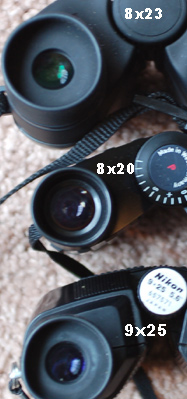 of
the optics is held at an equal level.....Going up from a very
high quality 20mm (roof) binocular to a 30mm very high quality
porro binocular yields stunning gains, and then when you go up
to a very high quality 56mm roof there is just as much, or more,
in the gain!
of
the optics is held at an equal level.....Going up from a very
high quality 20mm (roof) binocular to a 30mm very high quality
porro binocular yields stunning gains, and then when you go up
to a very high quality 56mm roof there is just as much, or more,
in the gain!
When viewing bino-sized celestial objects, eg. Orion Nebula, the "Wow" factor is very low at 20mm, good at 30mm (the wide angle & ease of view helps a lot, constituting a gain somewhat apart from just the gain in aperture; also, mini-binis are just more difficult to hold steady on the stars, whereas the wide, rubberized body of the 8x30 Hensoldt also helps build a good Wow factor). But the 30mm size "Wow" is nothing beside the "SuperWow" experience of the 56mm Zeiss Night Owl, especially enhanced by its gigantic wide field and superb ease of view. It's like the difference between an excellent 1.25 inch Orthoscopic eyepiece vs. a Televue Nagler!
A very interesting thing happens when one goes up to the 70mm Orion, which is a porro prism and thus with an inherent light transmission advantage over a roof prism like the Zeiss Night Owl... But surprisingly, it was very difficult for me to prefer the view through the 10x70 Orion over that provided by the Zeiss. The Orion's view showed marginally more faint stars, but overall its view seemed constricted, small and narrow, and it just did not encourage the viewer to really spend time at the eyepieces--- as astronomers well know, it takes time and patience at the eyepiece to fully develop the image that your eyes and brain are processing. If you are comfortable and spend the time, more and more fine, faint details emerge from an image, whether night or day, and especially so on faint astro objects. The Zeiss Night Owl clearly demonstrates this principle when compared to the Orion (see page bottom). The Orion's greater aperture, even with its excellent coatings and porro prism design, just don't beat out the superb optical quality and viewing ease of the significantly smaller Zeiss.
Copyright 2010-2019 by Bruce B. Johnson
Here is a new bino review comparing my mini binos-- (in this order, left to right-- older model Nikon 9x25 Travelite III --- Zeiss 8x20 B GA Diaylt with phase coatings (a rare model)--- and a Nikon 8x23 Aspherical Diplomat, introduced circa 1991.... Note: I have recently acquired a circa 1997 model B&L 7x24 Elite, a heavy but waterproof reverse porro design. Its high quality image will please the eye, although it is not quite up to the sharpness of the Nikon AS, and overall just lacks that slight edge of a Wow factor when compared to the Zeiss. (its picture is the instrument on the far right)
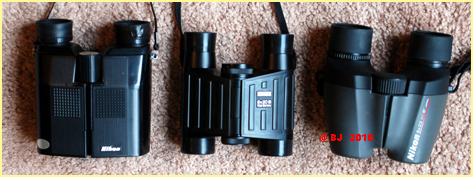
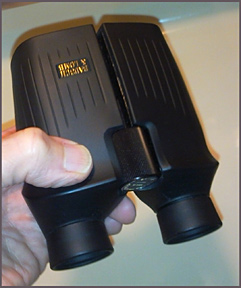
These are three minis with some deep differences. How can the tiny Zeiss 8x20 roof prism possibly equal the two reverse-porro Nikons? First, Roofs are inherently much more difficult to construct, and their basic optical designs cause more light loss than reverse porro prism designs. And secondly, the tiny Zeiss is going up against significantly larger apertures (20mm vs. 23mm and 25mm). How is this unequal contest going to come out? Nikon Travelite III, 5.6 degrees, vintage 1991--- Nikon Diplomat AS, 6.5 degrees, 1993--- The Zeiss Diaylt, 6.6 degrees, and listed for $600 in 1991 Zeiss pricelist.
Testing under various condtions soon eliminated the older Nikon 9x25 from the competition, no surprise. Not only does it have older, less-sophisticated coatings, but its original price point was 1/3 that of the Nikon Diplomat, and 1/6 th that of the Zeiss Diaylt.. Nevertheless, in its defense, it is not a piece of junk, a fine little casual or starter binocular for your child, or for travelling in a theft-prone area! --- In fact, my son owns a 2009 version of the Nikon 9x25, named the "Nikon Travelite V 9x25 CF" .... It is essentially the same design and specs as the older model, but has updated multi-coatings and some aspherical lens elements- it's somewhat brighter and more contrasty than its older cousin, but otherwise it's still not in the same league as the Zeiss or the Nikon Diplomat.
The 9x25 now eliminated, that put the Nikon aspherical Diplomat squarely up against the little Zeiss 8x20 Diaylt. (see previous review of the miraculous Diplomat in my first review, at page top).
First, a few words about this little Zeiss 8x20 Diaylt. Those familar with the classic Zeiss Diaylt line are well-aware of the greatness of these leaded-glass marvels, perhaps the best-known of which is the Zeiss 10x40 Diaylt, still commanding premium prices as a used binocular and regarded as one of the best naturalist/birding binoculars ever made (the other one is the Zeiss 7x42 Diaylt, which maintains absolute cult status within the birding community).. Thus, the smallest member of the Diaylt line ought to be of similar optical and mechanical excellence, and it is! One definitely ought not confuse the 8x20 Diaylt with the less expensive Zeiss 8x20 models produced through the years (which are great, but not in quite the same league as the Diaylt).
So the superb Nikon Diplomat does indeed face very serious competition in the Zeiss Diaylt. Here's what my testing revealed--
The Main testing arena had viewing conditions very similar to those used in Review #1-- lots of strong backlighting, providing challenging lighting conditions for any binocular.
A Mini-binocular user's Tip-- those accustomed to viewing through full-size binoculars will need a bit of time to adjust their eyes and brains and hands to mini-binoculars. . I find for myself that even stepping down from my Hensoldt 8x30s leads to a momentary impression at the eyepieces of the minis of, "so inferior, why bother?" But if you perservere, after 5 or 10 minutes, your eyes, brain and hands will make the adjustment, and soon you'll be appreciating the very fine viewing that the best of the minis can provide. Both of these minis have grippy rubberized exteriors, and I think that definitely helps the user achieve a steady grip on these little bodies.
Performance under severe glare/backlighting conditions: Both the Zeiss 8x20 and the Nikon 8x23 showed a good deal of glare under the most severe conditions. Their exact pattern was somewhat different, but essentially I rated them about equal. The one interesting finding was that the the main area of glare in the Nikon seemed to render the image behind it quite blurry, whereas in the Zeiss the image behind remained relatively sharp. In other than the worst conditions, however, both the Zeiss 8x20 and the Nikon 8x23 dealt well with "normal" glare, and glare control was not a normal issue for either binocular.... For comparison value, I also brought out the huge Zeiss 10x56 Night Owl and viewed the same scene. With the Night Owl, the glare control was superb even under the most severe condition-- making both of the smaller binoculars look almost defective in comparison! This was quite surprising-- one would think that controlling glare through those giant 56mm objectives would be much more difficult than through the little 20 or 23 mm objectives.
Sharpness/Resolution/Ease of Focus: even though the Zeiss Diaylt is not an aspherical design like the Nikon is, both binoculars were extraordinarily sharp, both displaying that luscious sharp, crisp, "Snap-To" focus indicative of the very best optics. This was a surprise to me, I thought that no other mini binocular could equal the sharpness and snap-to quality of the Nikon Diplomat. Both binoculars also possess focus controls that are precise and a joy to use (I'd give the Zeiss a definite edge here).
Performance under dim conditions: The old adage that the mini size are "daylight" binoculars turns out to be pretty much true, even for the very highest quality of the minis. They are usable under dim conditions, but you'll find even the smallest "all-arounders" like 8x30s much more pleasing (I'm assuming high-quality and modern multi-coatings). "Dim conditions" include: a dark rainy day, a day getting close to dusk, inside a concert hall, or viewing a sports game at night "under the lights." All are conditions where the larger apertures, even if only 8x30 size, make a noticeable difference. "Under the lights" at a sports arena watching soccer was actually the least challenging, and both the Zeiss 8x20 and the Nikon 8x23 did fine. Out on a field in the country, as the day really dimmed down toward dusk, both minis continued to pull out details I would have thought impossible, yet when I pulled out the Zeiss 10x56s I was blown away-- with the big Zeiss the scene's color and contrast just jumped right back out again, like turning on the lights!
Ease of View/Ergonomics: refer to the picture above of the relative eyepiece sizes of the three minis I tested. You'll note that the Zeiss eyepiece glass is very definitely larger in diameter than either of the other two. The Zeiss is also given the "B" designation, which means eyeglasses friendly, which the other two definitely were not. But eyeglasses aside, I found that the Zeiss eyepiece simply gave a better Ease of View, and had in fact a fairly good "IMAX EFFECT" (see Review #4), despite the technical fact that it does not even come close to meeting the criteria for a wide angle binocular (its AFOV is only 51 degrees).
Overall: both the Nikon Diplomat and the Zeiss 8x20 Diaylt were very impressive, both with many strengths and both well worth owning. The Diplomat is somewhat bigger and bulkier but a whole lot less expensive. The Zeiss Diaylt has no peer in its jeweled perfection, and possesses a sheer beauty of form and function. Both are now Collector's binoculars because they are no longer made (both went out of production more than ten years ago, and both were never made in large quantities).
Copyright 2015-2019 by Bruce B. Johnson
The commonly-used descriptor "Wide-Angle" is a loose industry-standard measured by the technical parameter of a 60-degree wide "Apparent Field of View" (AFOV). If the binocular produces 60 degrees or more, it is legitimate to advertise it as a "Wide-Angle Binocular." Those of us who have peered through a large number of binoculars, however, have realized that not all "wide-angle" binoculars "feel" the same to the human eye/brain. There is a second factor that goes into producing a truly spectacular "wide-angle" experience.
Think of the IMAX screen at OMSI, and then remember the fact that some smaller, more modest theater venues take the same IMAX filmstrip and project it onto a much smaller, less-enveloping screen. Well, it's still "wide-angle," still shows all the content of the filmstrip, but it's "just not the same." The Awesome enveloping effect of true IMAX has been lost.
That's what the eyepieces and prisms of lesser-quality wide-angle binoculars do to the image-- they diminish it rather than enhance it.
The Best of the Best Binoculars in the World have an almost magical ability to somehow combine both a wide apparent field of view with an eyepiece construction and prisms that create, for lack of a better word, a VAST field of view. One your mind can "fall into," and roam around in at leisure. A big, broad FOV that really draws you in, catches your attention in a way that the lesser wide-angle binoculars simply fail to accomplish.
I've had the pleasure to own or use on extended use tests three such wide-angle binoculars: the Zeiss Night Owl 10x56 roof prism; the Nikon Venturer 8x42 roof prism; and the Swarovski 15x56,.also a roof prism... Of these, the Zeiss Night Owl was the most impressive. Each time you'd put it back up to your eye, you'd again have the sensation, "Wow, what a HUGE VIEW." On a lesser plane, but still impressive, was the Hensoldt 8x30 DF, an older military porro prism built by Hensoldt, the military optics division of Carl Zeiss West Germany. I mention it to point out that the "IMAX" type binoculars are not limited to the ultra-expensive, big, heavy models. Out of the Hensoldt's much smaller eyepieces came quite a comfortable, impressively big viewing experience. But nothing matched the Zeiss Night Owl 10x56. In its tribute, I write this final paragraph:
Title: "A RARE AND PERFECT LIGHT"
It happened again today. I had the Zeiss Night Owls propped on the car window while I sat comfortably inside. I focused in on a forest and meadow scene some 300 yards away. It was a rather gray day, with light rain showers off and on, and at that moment the sky had become brighter, pregnant with the promise the sun might slip out for a moment or two. I admired the delicate variations in color and texture of the distant evergreens, and noticed the hints of spring green erupting on a little maple tree. Then I suddenly found myself transported. Like walking through a portal, there I was suspended in the air, 10 times closer to the scene, just suddenly THERE. And the scene itself wasn't just a "nice view" anymore, it had come alive with three dimensions and was glowing with an inner light that took my breath away. After a while, I took the Night Owls down and made myself resume normal life, thinking, "Maybe this is why the World's very best optics are made!"
Copyright Bruce B. Johnson 2010-2019
Resources for Titlemax: